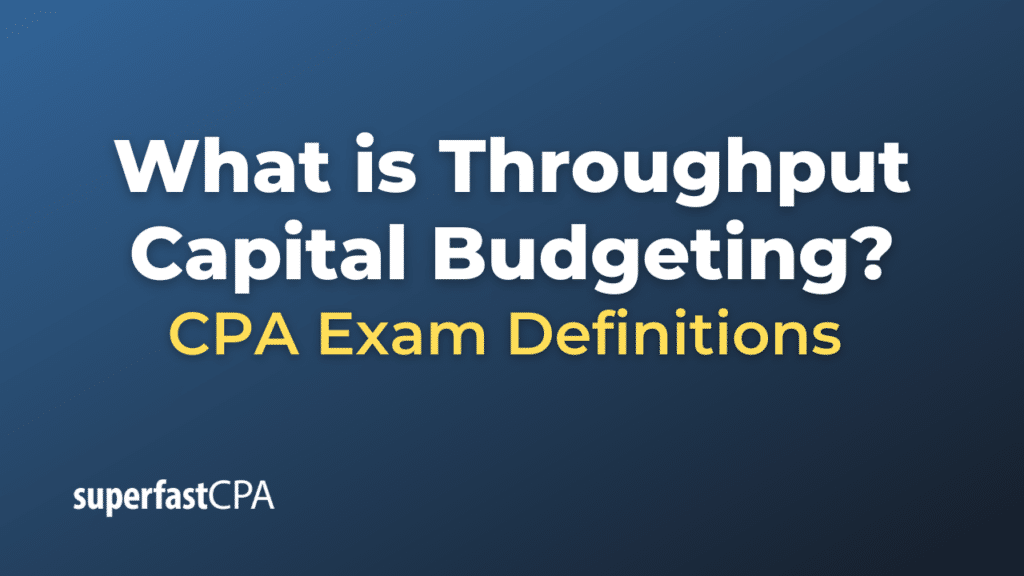Throughput Capital Budgeting
Throughput capital budgeting is an approach to capital budgeting decisions that primarily focuses on the impact of an investment or expenditure on the throughput of a system or organization. It derives its principles from the Theory of Constraints (TOC), which emphasizes the optimization of processes by identifying and addressing bottlenecks (constraints) that limit the performance of a system.
In the context of capital budgeting, “throughput” typically refers to the rate at which a system generates money through sales, less truly variable costs (like raw materials). The main focus of throughput capital budgeting is to evaluate potential investments based on their ability to increase throughput, rather than traditional metrics like return on investment (ROI) or net present value (NPV).
Here’s a step-by-step approach to throughput capital budgeting:
- Define the Throughput Contribution: Determine how much each unit produced contributes to throughput. This is calculated as the selling price minus the truly variable costs per unit.
- Identify Bottlenecks: Understand where in the process or system constraints exist that limit throughput.
- Evaluate Investment Impact: Assess how the proposed capital expenditure will impact the bottleneck. Will it increase the rate of production? Will it completely eliminate the constraint?
- Calculate Throughput Increase: Based on the anticipated improvement at the bottleneck, calculate the expected increase in throughput.
- Compare Investment to Increased Throughput: Contrast the cost of the capital expenditure to the anticipated increase in throughput over a specified time horizon. This will provide a clear picture of how the investment will impact the system’s financial performance.
- Make a Decision: Based on the analysis, decide whether to proceed with the investment. The key here is to prioritize investments that offer the greatest increase in throughput for the least capital outlay.
Example of Throughput Capital Budgeting
Let’s explore an example using throughput capital budgeting in a fictional scenario involving a manufacturing company:
Scenario: Alpha Manufacturing
Background: Alpha Manufacturing produces high-end widgets. They have identified Machine X as their primary bottleneck. Every hour Machine X operates, 10 widgets are produced. Each widget has a selling price of $200, and the truly variable cost (materials, direct labor) is $50. Therefore, the throughput contribution per widget is $150 ($200 – $50).
Current Situation:
- Machine X operates for 8 hours a day, producing 80 widgets.
- Daily throughput contribution: 80 widgets x $150/widget = $12,000.
Investment Proposal: The operations manager suggests buying a new version of Machine X for $300,000. This machine can produce 20 widgets per hour, doubling the current production rate.
Throughput Capital Budgeting Analysis:
- Define the Throughput Contribution:
- As previously calculated, the throughput contribution per widget is $150.
- Identify Bottlenecks:
- Machine X is the known bottleneck.
- Evaluate Investment Impact:
- The new machine will double the production from 10 widgets/hour to 20 widgets/hour.
- Calculate Throughput Increase:
- New daily production: 20 widgets/hour x 8 hours = 160 widgets.
- Increase in widgets produced daily: 160 widgets – 80 widgets = 80 widgets.
- Daily increase in throughput contribution: 80 widgets x $150/widget = $12,000.
- Yearly increase (considering 250 working days): $12,000/day x 250 days = $3,000,000.
- Compare Investment to Increased Throughput:
- Cost of new machine: $300,000.
- Yearly increase in throughput: $3,000,000.
- Net gain in the first year: $3,000,000 – $300,000 = $2,700,000.
- Make a Decision:
- The new machine would not only pay for itself within the first few months but also provides a substantial net gain by the end of the year. The investment seems justified based on the throughput analysis.
In this example, using throughput capital budgeting, Alpha Manufacturing can quickly see the potential benefits of the investment in terms of increased throughput. It provides a clear, operational-focused perspective that aligns with the goals of increasing production and profitability.













